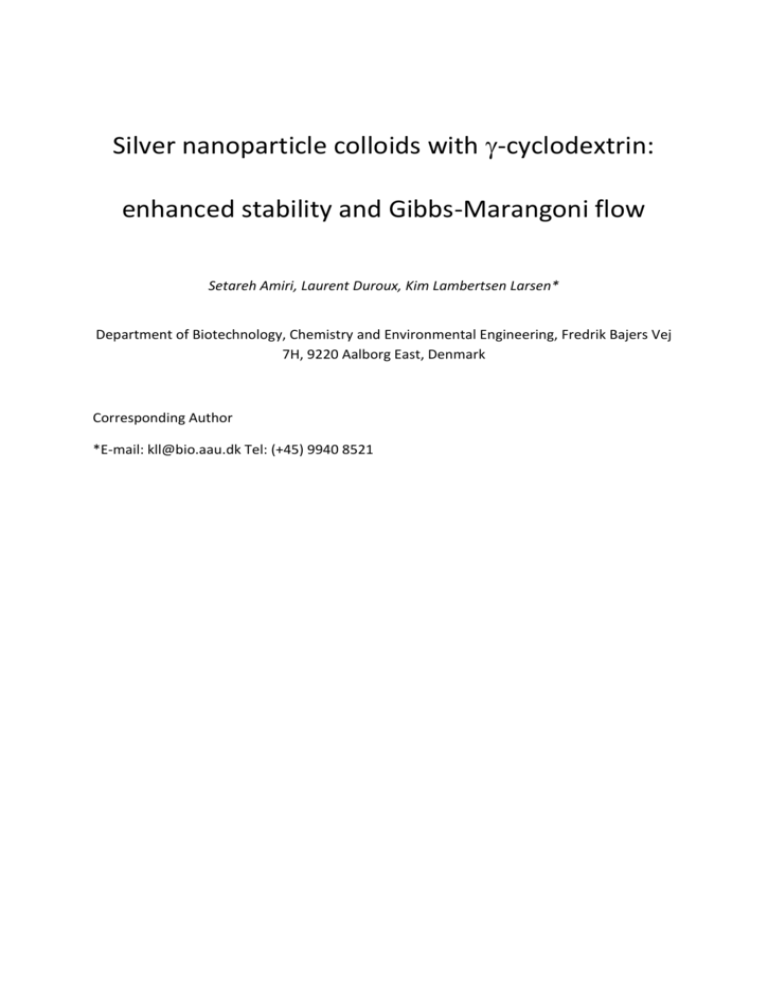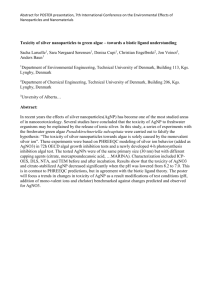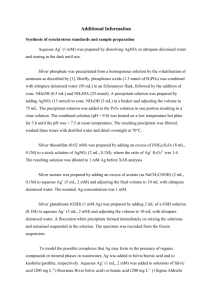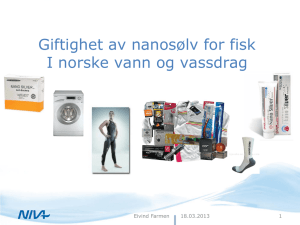Silver nanoparticle colloids with g-cyclodextrin: enhanced stability
advertisement

Silver nanoparticle colloids with -cyclodextrin:
enhanced stability and Gibbs-Marangoni flow
Setareh Amiri, Laurent Duroux, Kim Lambertsen Larsen*
Department of Biotechnology, Chemistry and Environmental Engineering, Fredrik Bajers Vej
7H, 9220 Aalborg East, Denmark
Corresponding Author
*E-mail: kll@bio.aau.dk Tel: (+45) 9940 8521
Sessile drying drop patterns from independent batches of AgNPs
In order to check for the reproducibility of the drying drop patterns, independent batches of AgNP
colloids were deposited onto a flat sheet of white polystyrene and left to air-dry at room
temperature. Figure S1 shows that only -CD-AgNP gave a ring pattern typical of a Marangoni-flow
regime.
Fig. S1 Sessile drying drop patterns from independent batches of AgNPs
Image analysis of colloids drying patterns
The digital picture of the drying patterns of the four droplets of AgNP colloids was analysed with
ImageJ v. 1.48u (W. Rasband, NIH, USA, http://imagej.nih.gov/ij/), which is bundled with ICY. From
the original picture in 8-bit RGB format, an inter-spot region (Figure S1B) was extracted to analyse
the composition of the background. This background is a combination of the thin plastic sheet onto
which the droplets were dried, light conditions and the inherent optical properties of the camera.
Frequency histograms of pixel values (from 0 to 255) for each RGB channel were derived from the
background area (dotted square area in Figure S1B). Distribution statistics of these histograms are
given in Table S1, from which threshold values were extracted. These threshold values were applied
to the whole picture in order to get colour-balanced pictures (Figure S1C and S1D), from which
details of the patterns and differences in colours are more clearly visible. In particular, the yellow
colour of the deposits from -CD-AgNP and-CD-AgNP is enhanced in Figure S1D to show the
regular spread of particles across the spot. The differences in colour are also indicative of a change in
plasmon resonance frequencies of AgNP. The grey/brown deposits for noCD-AgNP and -CD-AgNP
(to a lesser extent) are reminiscent of elemental silver, with a broad absorption band in the visible
spectrum, and suggest relatively big particles and aggregated forms. The yellow deposits for -CDAgNP and -CD-AgNP are indicative of smaller individual particles, with a sharper absorption band in
the blue (complementary to yellow). The central region for the -CD-AgNP spot was more red/brown
which indicates a different electronic configuration of the metallic nanoparticles, than with the rest
of the particles in the spot. A red colour would correspond to absorption in the green part of the
visible spectrum, which in turn would indicate a lower plasmon resonance frequency than the AgNP
giving the yellow colour. This apparent red-shift could be due to closely packed AgNP of small size, a
tight interaction of AgNP with -CD, or alternatively a change in refractive index in the middle of the
spot.
Fig. S2 AgNP colloid droplets (A) and dried patterns (B-C). From left to right: noCD-AgNP, -CD-AgNP,
-CD-AgNP, -CD-AgNP. A: 50 µL droplets of AgNP colloids on a polystyrene thin sheet, B: original
picture with all pixel values from 0 to 255 in all RGB channels, C: colour rescaling from 80 to 189 in R
channel, from 80 to 179 in G channel and from 80 to 160 in B channel, D: colour rescaling from 80 to
153 in R channel, from 80 to 137 in G channel and from 80 to 109 in B channel
Table S1 Pixel value statistics from selected background area. For each colour channel (Red, Green
and Blue), pixels were sorted into 256 bins (0-255) and the frequencies were computed. For each
colour channel, simple statistics of the frequencies distributions are presented. The total number of
pixels analysed was 274329.
Min
Max
Mean+StdDev
Mode
Red
153
189
174.2+2.1
175
Green
137
179
160.3+2.3
161
Blue
109
160
136.4+3.2
137
Calculations of parameters for the simulation of DLVO energies of AgNP - AgNP interactions
The effect of particle radius on AgNP concentration in the colloids was calculated to insure that
AgNP to AgNP average distance (from surface to surface) was low enough to satisfy the DLVO model.
The a/-1 ratio (particle radius to Debye length) was also calculated as DLVO theory assumes that
a/-1 ≥ 5 for precise approximations. Results from the following calculations are summarized in Table
S2. Average particle radius a for noCD-, -CD-, -CD- and -CD-AgNP were taken from TEM analyses
(Fig. 4 in the manuscript). The number of Ag0 atoms n in a particle as a function of its radius was
calculated as follows: 𝑛 =
𝑑 𝑣 𝐸 −27 𝑁𝐴
𝑚𝑎
with d = 10.49 106 g m-3 the solid-phase density of Ag0 at r.t., v
the volume in nm3 of the particle assuming a spherical shape, NA = 6.02 1023 mol-1 Avogadro’s
number, ma = 107.9 g mol-1 the molar atomic mass of Ag0. Assuming that all initial Ag+ ions were
reduced to Ag0 into particles, the concentration of AgNP was derived by dividing the initial
concentration c = 10-4 M by the number of Ag0 atoms per particle. Particles surface-to-surface
distance D was calculated as function of the volume fraction of Ag0, as follows: 𝐷 () =
1
m 3
2𝑎 {( )
− 1} with m = 0.64 defining the maximum packing density of a randomly packed hard
sphere, and the volume fraction of Ag0 such as =
𝑐 𝑚𝑎
𝑑
. The reciprocal Debye length -1 was
calculated for a symmetrical monovalent electrolyte at a concentration of 5 10-3 M, corresponding to
the initial concentration of NaBH4, and gave a value of 4.3 nm (see equation (6) in Bhardwaj et al
2010). The other electrolyte present in the solution was AgNO3 at 10-4 M which was neglected.
Table S2 Calculated AgNP concentrations, inter-particle distances D and particle radius/Debye length
ratios.
AgNP
Sample
-CD
Radius a
(nm)
2.5
Volume v
(nm3)
65.4
Ag0 atoms
(/AgNP)
3832
[AgNP]
(M)
2.61E-08
D ()
(nm)
4264
a/-1
-CD
3.0
113.1
6621
1.51E-08
5117
0.70
-CD
3.5
179.6
10514
9.51E-09
5970
0.81
no-CD
7.5
1767.1
103453
9.67E-10
12792
1.74
0.58
The effects of AgNP particle radius a on UDLVO (D) for a fixed -potential, and inversely the effect of potential on UDLVO (D) for a fixed particle radius are illustrated on Fig. S3.
Fig. S3 Effect of particle size (A) and -potential (B) on DLVO potential energy surfaces. A The potential of the particles was set to -40 mV. B The radius a of the particles was set to 7.5 nm. All
other parameters were as stated in the main text. Energies are scaled to kT and are therefore
dimensionless in this representation.







